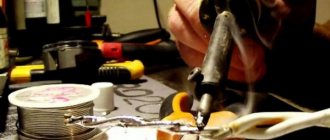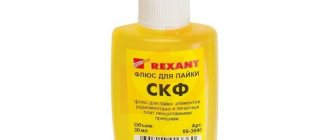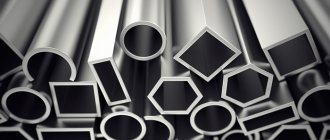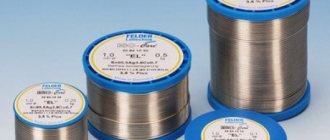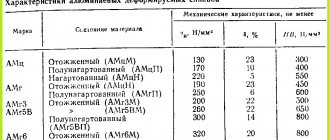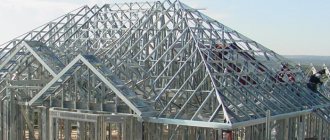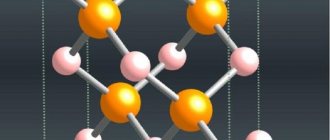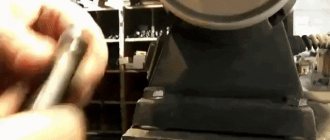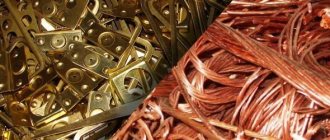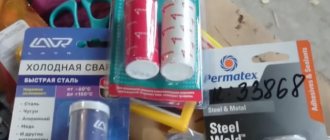Fluxes for aluminum
Soldering aluminum is a rather complex technological process. In addition to the oxide film on the surface of aluminum, the process is complicated by the need to expose it to higher temperatures than when soldering copper. However, aluminum can be soldered because special fluxes have been developed for this purpose.
The main task of flux for low-temperature soldering of aluminum is to dissolve the oxide film, which interferes with the normal spreading of solder and joining of parts. For soldering aluminum, only active fluxes containing acid are used. Rosin and other similar inactive fluxes are absolutely not suitable for these purposes.
Flux composition for aluminum
The main components of active fluxes for soldering aluminum at temperatures below 300 degrees are organic acids and their amides, as well as triethanolamine. The most active acids are oleic, elaidic, formic and acetic acid.
This is due to the fact that the activity of all of the above acids increases with increasing temperature. Therefore, by acting on Al2O3 oxide, they are able to completely destroy it, which will allow the solder to adhere normally to the surface of the aluminum parts being soldered.
Hardwired
Purpose of flux
| Brand | Appearance | Solderable metal or metal coating | Solders used | Purpose |
| Rosin grade A | Copper; silver, tin, zinc, tin-lead, tin-bismuth, gold coatings | Tin-lead, tin-lead-cadmium (at soldering temperatures above 220°C), silver PSr1.5 and PSr2 | Manual and mechanized soldering and tinning of mounting elements and other surfaces. Preservation of the product to preserve solderability under warehouse storage conditions. | |
| FKSp (FKEt) | Light brown liquid | Same | Same | The same, as well as soldering of conductors with insulation in the form of tubes or enamel insulation, products with increased requirements for insulation resistance |
| FCDT | Dark brown liquid | Copper; silver, tin, tin-lead, tin-bismuth, gold coatings | Tin-cadmium-indium, tin-lead, tin-lead-bismuth, tin-lead-cadmium, indium | Manual and mechanized soldering and tinning of mounting elements and other surfaces. |
| LTI-120 | Dark brown liquid with slight sediment | Carbon steel, copper and its alloys, nickel and its alloys; tin, silver, cadmium, zinc, tin-lead, tin-bismuth coatings | Tin-lead, silver PSr1.5 and PSr2 | Manual and mechanized soldering and tinning of mounting elements that do not have insulation in the form of tubes on the terminals, and other surfaces in widely used products. |
| FGSp, FSkSp, FSkPs | FGSp, FSkSp – colorless liquid; FSkPs – homogeneous paste of light yellow color | Copper and its alloys, nickel and its alloys; tin, silver, cadmium, zinc, tin-lead, tin-bismuth coatings | Tin-lead, tin-lead-bismuth, tin-lead-cadmium | Manual (FSkPs and FSkSp) and mechanized soldering and tinning of mounting elements that do not have insulation on the terminals in the form of tubes and other metal surfaces in widely used products |
| FCS | Yellow liquid | Copper; tin, silver, cadmium, zinc, tin-lead, tin-bismuth coatings | Tin-lead, tin-lead-bismuth, tin-lead-cadmium | Manual and mechanized soldering and tinning of mounting elements and other metal surfaces in consumer products |
| FDGL | Colorless thick liquid. At soldering temperature – brown | Same | Tin-lead | Manual and mechanized soldering and tinning of consumer products. Group soldering by immersion in soldering flux at a temperature of 220–250°C and melting of electrolytically tin-coated parts before soldering |
| FCA | Colorless liquid | Copper and its alloys (including BrB), carbon and stainless steels, nickel and its alloys | Tin-lead and low temperature silver | Pre-tinning (mechanized and manual) and soldering of products, subject to complete removal (using neutralizing solutions) of flux residues after soldering, except for mounting connections |
| FDFs | Colorless liquid | Steel, chromium-nickel alloys (nichrome, permalloy, superinvar, kovar, invar), copper and its alloys | Tin-lead | Manual and mechanized soldering and tinning of products, except for mounting connections |
| ZhZ-1-AP, ZhZ-2-AP | Viscous dark brown liquid | Tin-lead | Protection of the molten solder surface from oxidation in mechanized soldering installations | |
| 284, 209 | White powder | Copper and its alloys, stainless and structural steels, heat-resistant alloys | Silver | Soldering of electronic components and various structures using gas-flame heating and in furnaces |
| 200 | White powder | Stainless and structural steels, heat-resistant alloys | Brass and solders with a melting point of 850–1000°C | Soldering of electronic components and various structures using gas-flame heating and in furnaces |
| 34A, F370A | White powder | Aluminum and its alloys, except alloys with magnesium content above 3% | Aluminum | Soldering of electronic components |
| 16VK | Aluminum and its alloys | Aluminum | Soldering of electronic components. Group soldering of components by immersion in a salt bath |
Flux composition. Removing flux residues
| Brand | Composition (weight) | Removing flux residues after soldering | |
| Component | % | ||
| FKSp (FKEt) | Pine rosin | 10 – 60 | Ethyl alcohol or alcohol-gasoline mixture 1:1 |
| Ethyl alcohol or ethyl acetate | 90 – 40 | ||
| FCDT | Pine rosin | 10 – 20 | |
| Dimethylalkylbenzyl ammonium chloride (kitamine AB) | 0,1 – 3,0 | ||
| Tributyl phosphate | 0,01 – 0,10 | ||
| Ethyl alcohol or ethyl acetate | 89,89 – 76,90 | ||
| LTI-120 | Pine rosin | 20 – 25 | |
| Diethylamine hydrochloride | 3 – 5 | ||
| Triethanolamine | 1 – 2 | ||
| Ethanol | 76 – 68 | ||
| FGSSp | Hydrazine hydrochloride | 2 – 4 | Hot running water (70±10°C) or alcohol-gasoline mixture 1:1 |
| Ethylene glycol or glycerin | 25 – 50 | ||
| Ethanol | 73 – 46 | ||
| FSkSp | Semicarbazide hydrochloride | 2 – 4 | |
| Ethylene glycol or glycerin | 25 – 50 | ||
| Ethanol | 73 – 46 | ||
| FSkPs | Semicarbazide hydrochloride | 3 – 5 | |
| Glycerol | 70 – 58 | ||
| Polyox-100 or Polyox-115 | 27 – 37 | ||
| FCS | Salicylic acid | 4,0 – 4,5 | Alcohol-gasoline mixture 1:1 |
| Triethanolamine | 1,0 – 1,5 | ||
| Ethanol | 95 – 94 | ||
| FDGL | Diethylamine hydrochloride | 4 – 6 | Hot running water (70±10°C) |
| Glycerol | 96 – 94 | ||
| FCA | Zinc chloride | 45,5 | Hot running water (70±10°C) and neutralizing reagents |
| Ammonium chloride | 9 | ||
| Water | 45,5 | ||
| Zinc oxide hydrate | Before precipitation occurs | ||
| FDFs | Diethylamine hydrochloride | 20 – 25 | Hot running water (70±10°C) or alcohol-gasoline mixture 1:1 |
| Ethylene glycol | 60 – 50 | ||
| Phosphoric acid (specific gravity 1.7) | 20 – 25 | ||
| ZhZ-1-AP | Cylinder oil “52” or “KS-19” | 79 – 81 | Alcohol-gasoline mixture 1:1, trichlorethylene, acetone |
| Organosilicon liquid PFMS-6 | 16 – 17 | ||
| Oleic acid | 4,9 – 1,8 | ||
| Antioxidant NG-2246 | 0,1 – 0,2 | ||
| ZhZ-2-AP | Cylinder oil “52” or “KS-19” | 58,52 – 69,75 | |
| Organosilicon liquid PFMS-6 | 21,65 – 10,66 | ||
| Cottonseed oil | 11,0 – 10,64 | ||
| Oleic acid | 8,79 – 9,02 | ||
| Antioxidant NG-2246 | 0,04 – 0,03 | ||
| 284 | Boric anhydride | 23 – 27 | Hot running water (70±10°C) and cold running water |
| Potassium fluoride | 33 – 37 | ||
| Potassium borofluoride-hydrogen | 44 – 36 | ||
| 209 | Boric anhydride | 33 – 37 | |
| Potassium fluoride | 40 – 44 | ||
| Potassium borofluoride-hydrogen | 27 – 19 | ||
| 200 | Boric anhydride | 70 – 62 | Hot flow and neutralizing reagents |
| Sodium tetraborate (borax) | 17 – 21 | ||
| Calcium fluoride | 13 – 17 | ||
| 34A | Potassium chloride | 56 – 44 | |
| Lithium chloride | 29 – 35 | ||
| Zinc chloride | 6 – 10 | ||
| Sodium fluoride | 9 – 11 | ||
| F370A | Potassium chloride | 51 – 46 | |
| Lithium chloride | 36 – 39 | ||
| Sodium fluoride | 4 – 5 | ||
| Cadmium chloride | 9 – 10 | ||
| 16VK | Sodium chloride | 12 | |
| Potassium chloride | 44 | ||
| Lithium chloride | 34 | ||
| Eutectic (aluminum fluoride – 54%, potassium fluoride – 46%) | 10 | ||
Table 3 influence of flux residues on insulation and their corrosive effect
| Brand | Effect of flux residues on insulation resistance | Corrosive effect of flux residues | |||
| for copper | for silver plating | on tin-lead coating | for nickel coating | ||
| FKSp (FKEt), FKDT | do not affect | do not provide | |||
| LTI-120, FGSp, FSkSp | reduce | provide | do not provide | ||
| FSkPs | reduce | provide | do not provide | provide | do not provide |
| FCS | reduce | have a weak | do not provide | ||
| FDGL | reduce | provide | have a weak | do not provide | n/a |
| FDFs | reduce | provide | do not provide | do not provide | provide |
| FCA | reduce | provide | |||
| ZhZ-1-AP, ZhZ-2-AP | do not affect | do not provide | — | ||
When soldering copper conductors, as well as grounding conductors to the armor and lead sheath of cables, use solder paste of the following composition (in weight parts):
- Rosin…………………………………….. 10;
- Animal fat………………………………. 3;
- Ammonium chloride ………………………… 2;
- Zinc chloride…………………………….. 1;
- Water or rectified ethyl alcohol.. 1.
For the same purposes, the following composition is often used for solder paste:
- Rosin……………………………………… 2.5%;
- Salo ……………………………………………. 5 %;
- Zinc chloride……………………………20%;
- Ammonium chloride …………………………. 2%;
- Technical Vaseline……………………… 65.5%;
- Distilled water………………….. 5%.
Flux for soldering aluminum
| Brand | Compound, % | Melting point, °C | |||||
| Potassium chloride | Sodium chloride | Lithium chloride | Sodium fluoride | Cryolite grade K-1 | Magnesium chloride | ||
| YOU | 50–55 | 30–35 | — | — | 10–20 | — | 630 |
| AF-4A | 50 | 28 | 14 | 8 | — | — | » 600 |
| HP | 50 | — | 30 | — | — | 20 | |
VAMI flux is used for terminating wire and cable cores, AF-4A flux is used only for connecting cable cores in couplings.
Fluxes for soldering with soft and semi-hard solders according to electrical standards 0AA.614.017-67 and 0AA.614.028-68
| Brand | Purpose | Compound | Cleaning after soldering | |
| Component | % | |||
| TO | Tinning and soldering of current-carrying parts made of copper and its alloys | Pine rosin | 100 | Not required |
| KSP | Tinning and soldering of current-carrying parts made of copper and its alloys | Pine rosin | 25 | Not required |
| Technical ethyl alcohol grade B | 75 | |||
| FPP | Tinning and soldering of current-carrying parts made of copper and its alloys | Polyester resin grade PA9 | 20–30 | Not required |
| Methyl ethyl ketone or ethyl acetate | 80–70 | |||
| STUZO-12224-61 | Tinning and soldering of current-carrying parts made of copper, nickel and their alloys and parts coated with copper, tin, cadmium, silver and zinc | Pine rosin | 20–35 | Swab or brush soaked in solvent or alcohol |
| Diethylamine hydrochloride | 3–5 | |||
| Triethanolamine | 1–2 | |||
| Technical ethyl alcohol grade B | 76–68 | |||
| F59A 0AA.614.017-67 | Tinning and soldering of aluminum and AMts alloy with each other and with copper and its alloys | Cadmium borofluoride | 10 | Running hot water or alcohol |
| Zinc borofluoride | 3 | |||
| Ammonium borofluoride | 5 | |||
| Triethanolamine | 82 | |||
| 34A 0AA.614.017-67 | Soldering of aluminum and its alloys (melting point 420 °C) | Cadmium fluoride | 50±6 | Hot, then cold running water |
| Lithium chloride | 32±6 | |||
| Zinc chloride | 8±2 | |||
| Sodium fluoride | 10±1 | |||
| LM1 | Tinning and soldering of iron-nickel alloys and stainless steels | Pine rosin | 20–35 | Swab or brush soaked in solvent or alcohol |
| Diethylamine hydrochloride | 3–5 | |||
| Triethanolamine | 1–2 | |||
| Technical ethyl alcohol grade B | 76–78 | |||
| F38N | Tinning and soldering nichrome between itself and copper | Diethylamine hydrochloride | 25–30 | Hot water or a brush dipped in alcohol |
| Ethylene glycol | 60–50 | |||
| Phosphoric acid | 29–25 | |||
Flux brands for aluminum soldering
Flux F59A - intended for low-temperature soldering of aluminum, as well as AMts alloy with copper and steel, at temperatures from 150 to 320 degrees.
Flux F61A - in addition to soldering aluminum, it is intended for soldering parts made of galvanized iron, copper and beryllium bronze. The temperature for working with flux, as in the previous case, is 150-320°C.
Flux F54A - consists of 82% triethanolamine. This flux is also intended for soldering aluminum and its alloys at home.
Flux F64 - suitable for soldering aluminum and duralumin.
This version of the flux for aluminum is somewhat reminiscent of the LTI-120 soldering flux, which is intended for soldering copper, nickel and carbon steel. When F-64 flux is applied to the surface of aluminum parts, and under the influence of high temperatures, it is able to destroy the durable film of aluminum oxide, thereby cleaning the metal for normal spreading of solder.
All of the above fluxes are suitable for soldering aluminum. Well, you can always find out how to solder wires on the website.
What can be soldered with flux for aluminum F-64:
- - twisting of aluminum wires
- - soldering of aluminum and copper wires (direct contact of these metals is highly undesirable)
- - capacitor flasks
- — Al wire to galvanized terminal
- - aluminum radiators
What to solder with?
Depending on the size of the parts, their heat capacity changes. And since we are also talking about the material used for radiators, a lot of heat will be needed. For wires with a cross-section of 1.5-2.5 mm2, a 40-watt soldering iron will be sufficient. For more than 2.5 mm2 you will already need a 60 - 80 Watt soldering iron. From 4 mm it is better to take 100 W. If we are talking about corners, then you will need a burner. Liquid flux is applied at the very end so that it does not have time to evaporate.
